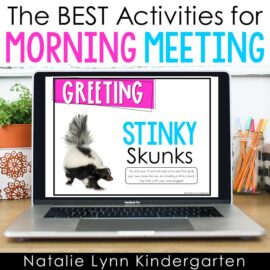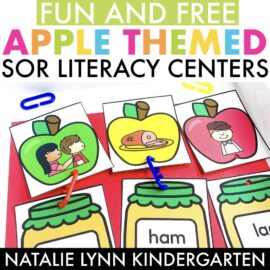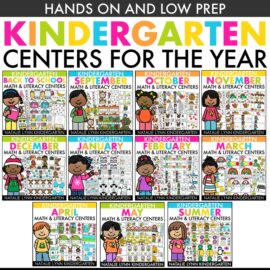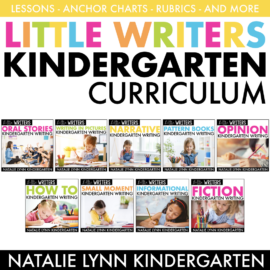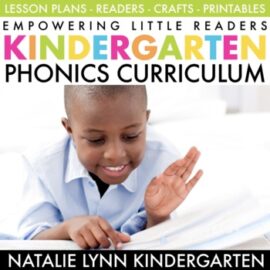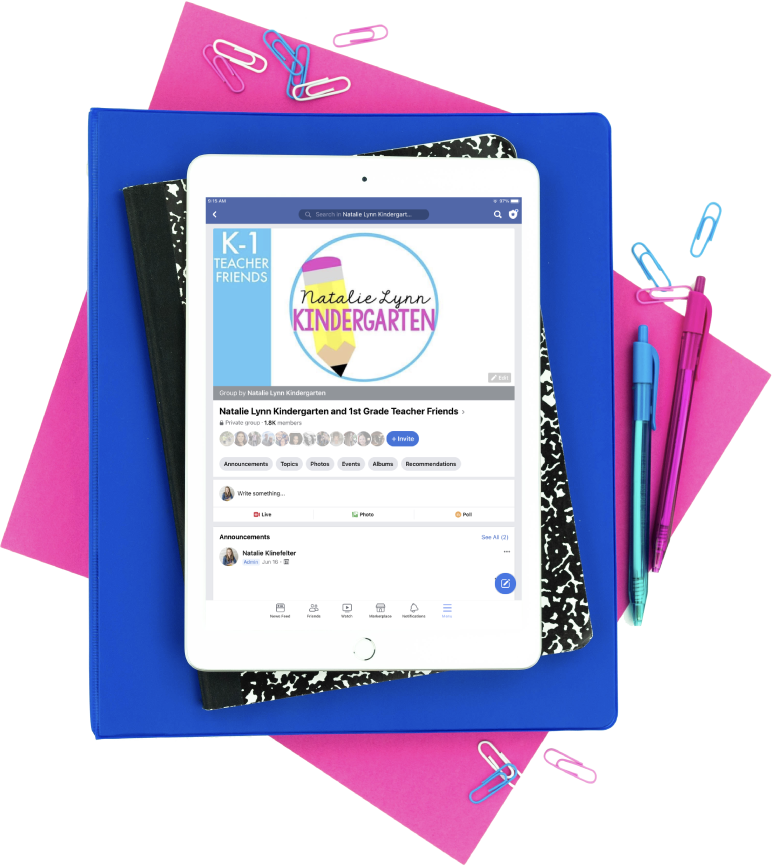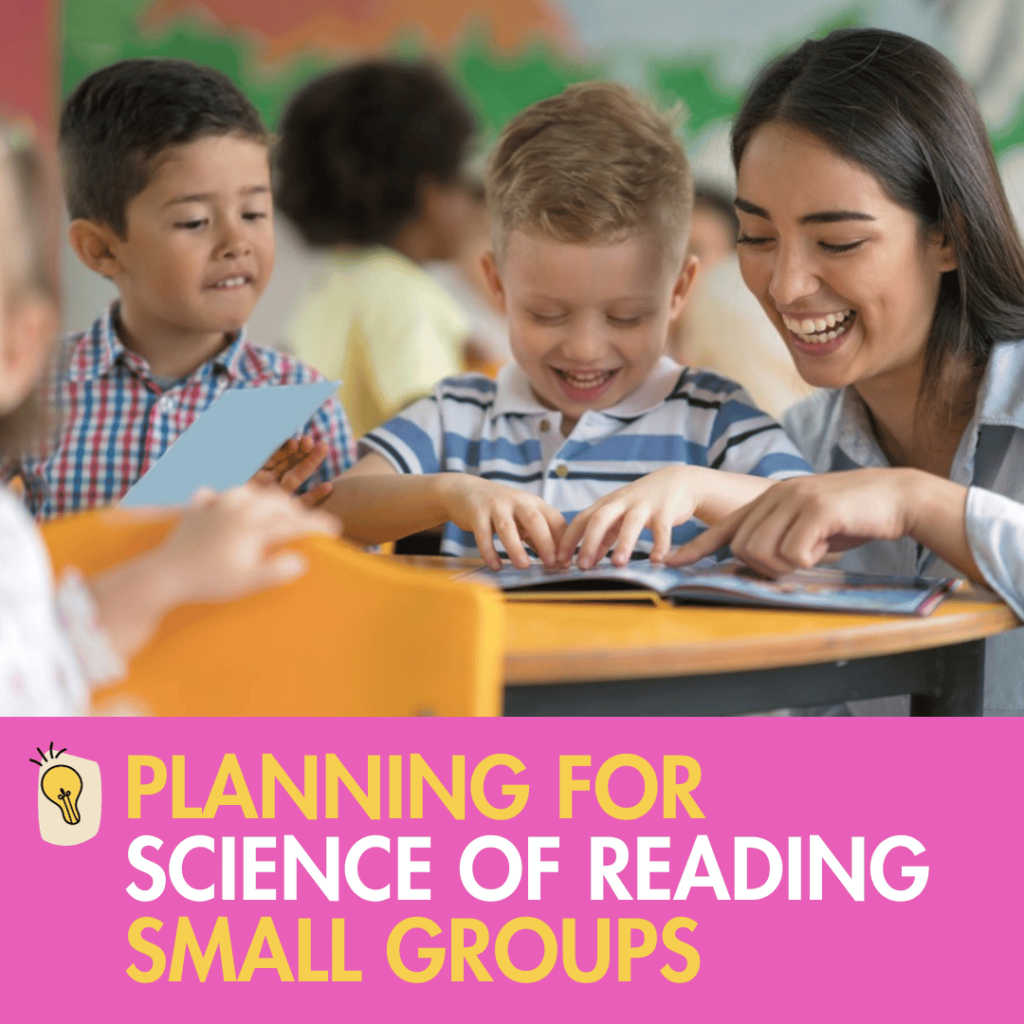
In this blog post: Are you new to Science of Reading aligned small groups (or just want to streamline your planning)? Let me walk you through planning and writing a Science of Reading small group lesson plan.
As teachers, the one thing we are really good at is overthinking. And I do mean this in the best way possible!
We want what’s best for our students, but sometimes we can get caught up in the “what ifs.” What if there’s a better, more effective method than what I choose? What if I try this and it ends up doing more harm than good? Will I completely fail these students?
We’ve all been there, right?
This is something I noticed especially when teachers began making the switch to Science of Reading aligned small groups.
It can be easy to overthink things when we start planning for our reading small groups. How do I choose what to focus on? What will give me the most bang for my time?
However, it doesn’t have to be complicated!
In this blog post, I will walk you step-by-step through planning an easy and effective Science of Reading small group lesson plan.
This blog post contains Amazon Affiliate links.
Who are Science of Reading Small Groups for?
When we talk about Science of Reading aligned small groups, we really mean reading small groups that utilize resources and strategies that have been shown to be effective in helping beginning readers learn to read.

For that reason, the students who will benefit the most from this Science of Reading small group lesson plan will be your students who are still working along a phonics scope and sequence.
You can determine who that is and which skills to focus on by using this free placement assessment.
That doesn’t mean that you don’t still use research-back practices when working with students who have mastered the phonics scope and sequence – students we would most likely call fluent readers. However, the focus of your small groups will change for these students.
Your small groups will also look different for your pre-readers. These are your students who are still learning letters and letter sounds.
For this blog post, we will be planning Science of Reading small groups for beginning and emerging readers. Your students who are ready to begin decoding but still have deficits in the phonics scope and sequence.
Before You Begin Planning
Before you begin planning your Science of Reading small group lesson plans, there are a few steps you must complete first.
1. Assess your students
Use the free placement assessment to assess all of your students and identify what their strengths are and where their deficits are.

Be cognizant of how much support you are offering students, even unintentionally, during this assessment. You really want to know what students can and cannot do on their own and how fluent they actually are.
2. Group your students
Once you have assessed your students, group them by deficit. This means, if you have a group of students who passed the CVC words portion of the assessment but did not pass the digraphs portion, you will group them together.
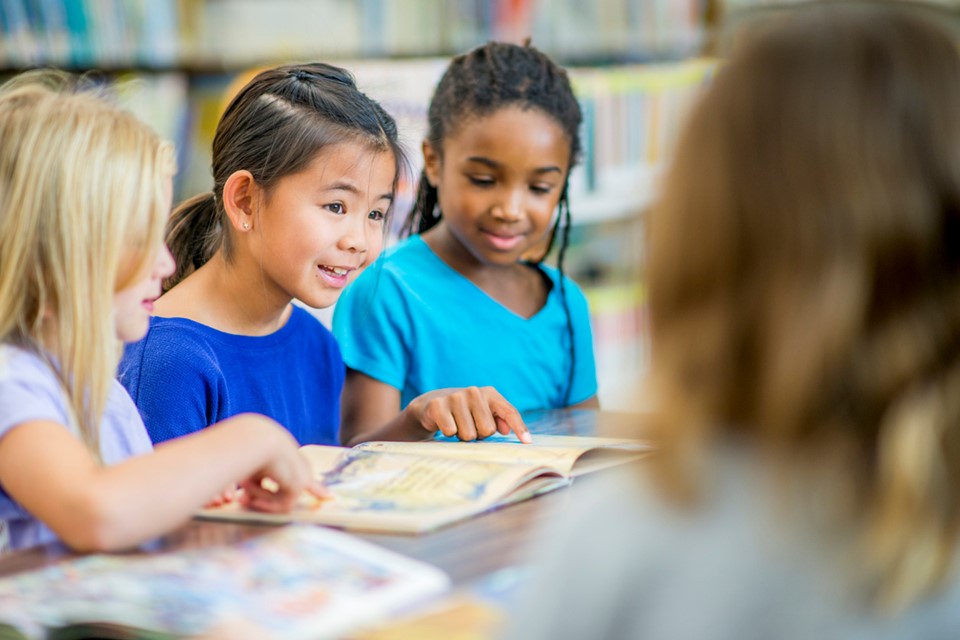
You may also have multiple groups within a skill. For example, you might have students who can read words with that phonics skill fluently but they struggle with writing. You would group those students together and know that your small group will have a heavier focus on encoding.
3. Gather your resources
Now that you have grouped your students by deficit, you know that those areas of deficits will be the focus of your Science of Reading small group lesson plans. It’s time to gather resources to help support your instruction such as:
- Word lists for each phonics skill
- Decodable readers or texts
- Sound sorts
- Any supplemental material you might want
In this blog post, I will use the materials from my Science of Reading Guided Curriculum as examples. However, you can use any resources you have so long as they align with your scope and sequence.
Writing your Science of Reading Small Group Lesson Plans
Now it is officially time to plan for and write your Science of Reading small group lesson plans! You will want to allot about 20 minutes for each small group.
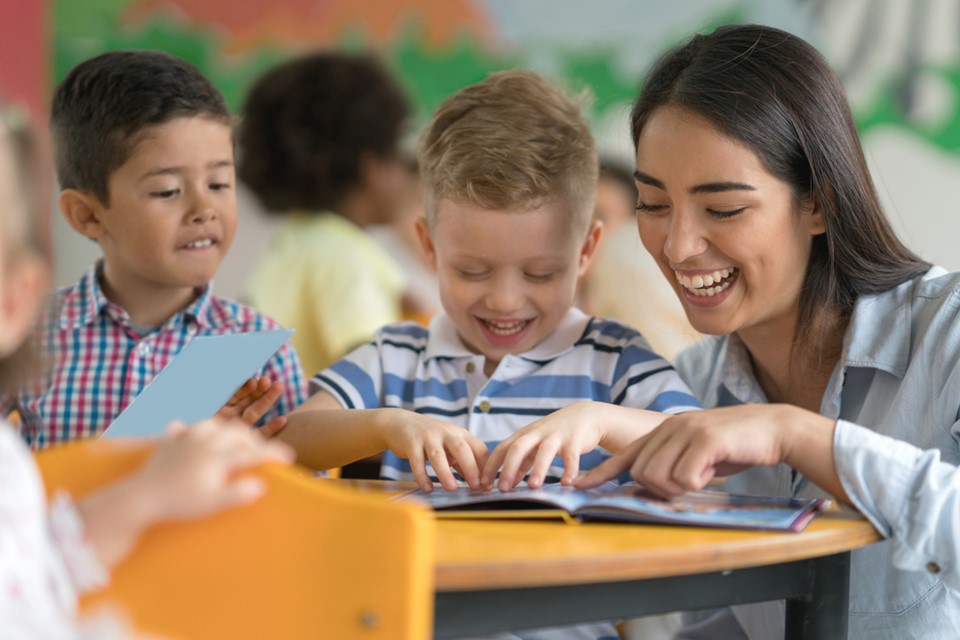
We can break those 20 minutes down like this:
- Warm Up (1-2 minutes)
- Focus Lesson (3-5 minutes)
- Blending Practice (2-3 minutes)
- High Frequency Words (2 minutes)
- Reading (5-8 minutes)
- Writing (5 minutes)
Most of my small group lesson plans are a two-day lesson plan, which means one day will be introducing the new skill and one will be review.
Let’s take a closer look at each of those sections.
Warm Up
The purpose of the small group warm up is to get students focused and ready to learn. This activity is not the focus of your lesson, so it should be very quick.
Your small group warm up should be about 1-2 minutes long and will most likely be completely oral, but it doesn’t have to be.
Choose the small group warm up activity based on phonics or phonemic awareness skills you want to review and strengthen.
Some ideas for Science of Reading small group warm up activities include:
- An alphabet or sounds chart routine (grab a free alphabet chart here)
- Finding sounds on an alphabet and sound chart as you say them
- Phonemic awareness activities
You can find 39 easy phonemic awareness activities here that would be perfect as small group warm ups.
Focus Lesson
The focus lesson is the “I do” and the “we do” portion of your small group lesson. This is a teacher-led mini lesson on a specific phonics skill or decoding strategy.
It is very important that this instruction is data-driven!
When planning your Science of Reading small group lesson plans, choose the focus of these lessons based on your students’ deficits. For example, if you have a small group who is working on short vowel sounds, that will be the focus of your mini lesson.
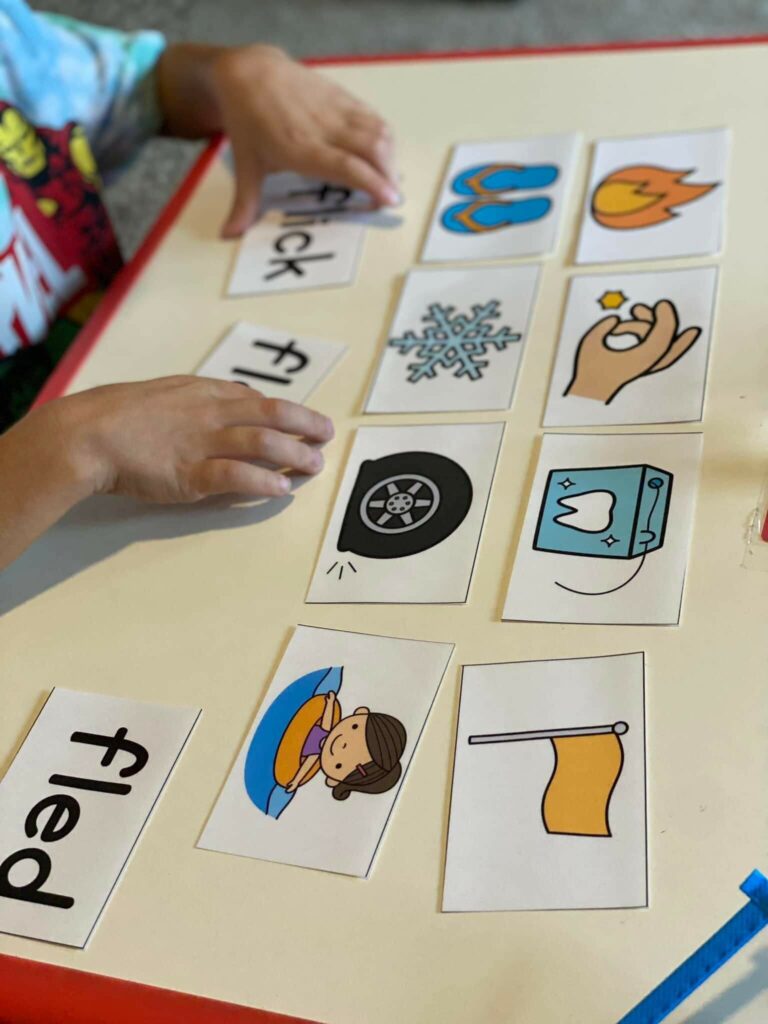
The Focus Lesson is a mini-lesson, which means it should only be about 3-5 minutes max. Keep this short and sweet!
In this Focus Lesson, you can:
- Introduce or review the skill
- Model decoding or writing words with the skill for students
- Offer a hands-on practice activity
Some ideas for the hands-on practice activity include:
- You write a word on a dry erase board, find the target sound together , and decode
- Matching pictures cards to word cards
- Picture sorts by sound
- Word chains
Blending Practice
The blending practice portion of your lesson plan is when you will start working on decoding and building fluency at the word level.
On day one of the lesson plans, this is very teacher-supported. On day two, I give my students a chance to work on fluency more independently.
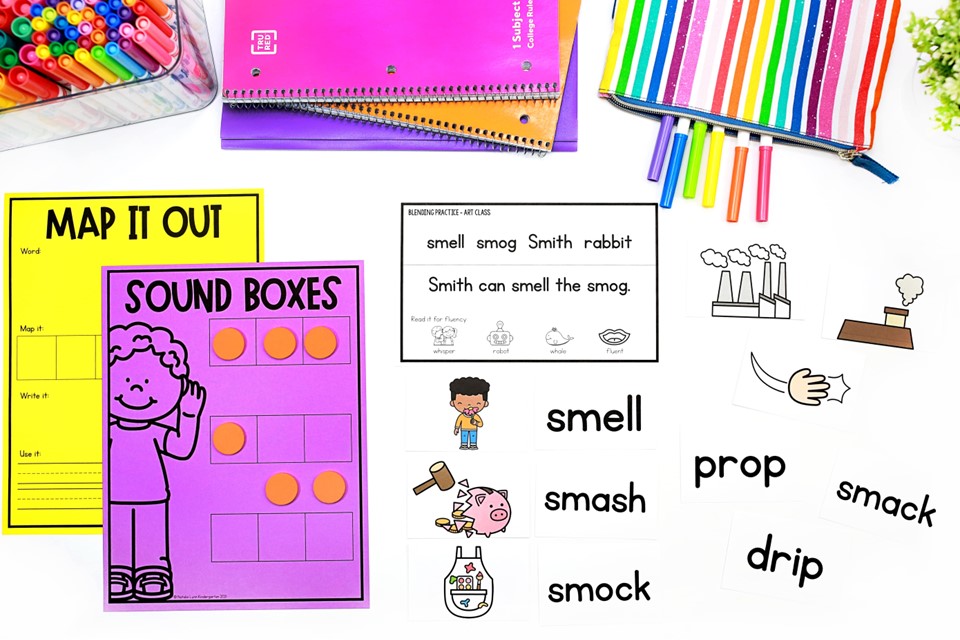
The day one routine can look like:
- Show students a word. Find any target letters or chunks in the word and review the sound.
- Say each sound together.
- Blend the word together.
- Re-read for fluency.
- Repeat with several words. You may give students a chance to try it without you after a few words.
On day two, I want to give my students a chance to try decoding and reading words on their own. For this, we use half-page blending sheets.
These sheets have a row of words with the target skill for students to practice decoding. You can have students read these once or a couple times through.
Then, students will read a sentence that uses the words in context. Students will read this sentence 4x for fluency.
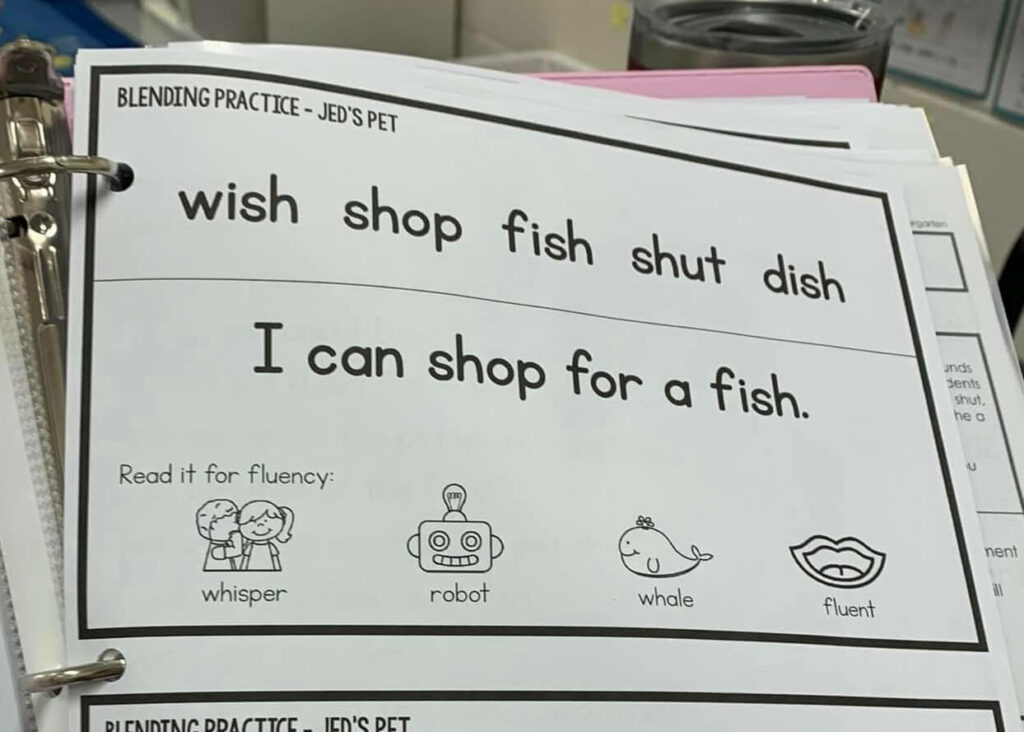
The different voice options at the bottom are just a fun way to get students engaged in reading the sentence multiple times, but you don’t have to use them! This would look like:
Whisper Voice: Read the sentence in your quietest whisper.
Robot Voice: Read the sentence in your best robot voice.
Whale Voice: Read the sentence like Dory in Finding Nemo when she speaks whale, streeeetching out the words and cadance.
Fluent Voice: Read the sentence fluently.
Alternatives to these half-page blending sheets could be blending cards, pyramid words or pyramid sentences, fluency sheets, or interactive decoding activities like spin and read or roll and read.
Just be mindful of how much time you are taking on this activity! This is an important part of your small group, but there is more to fit in.
High Frequency Words
Before reading, you will want to introduce any new high frequency words or review a previous high frequency word that students may still struggle with.
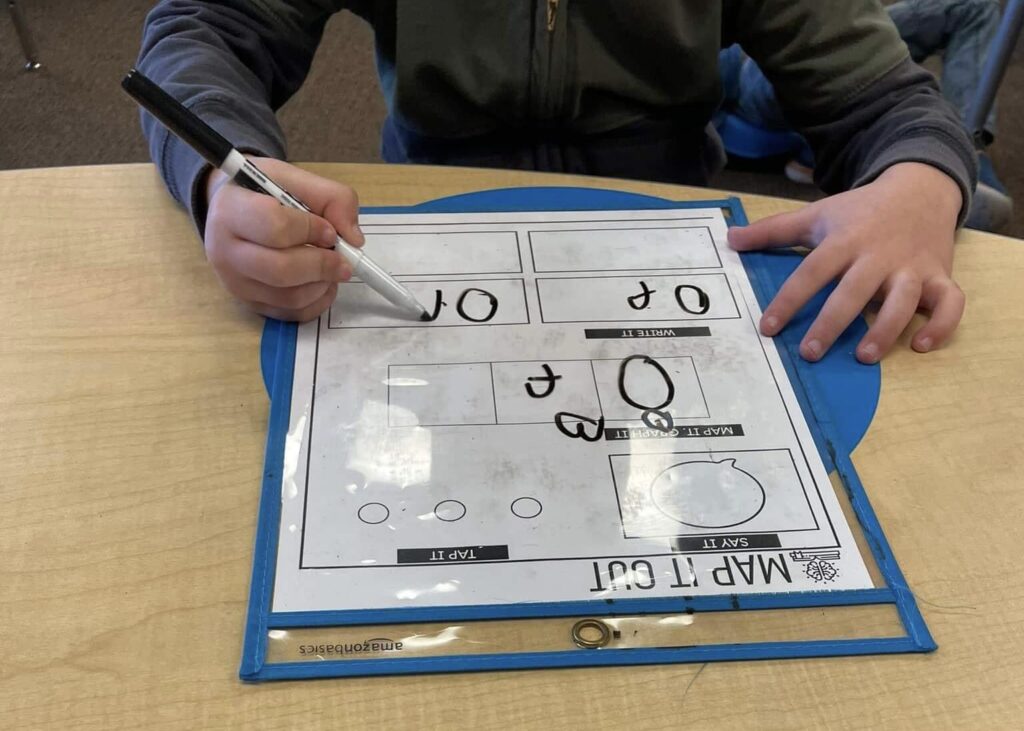
Note: When choosing texts, try to choose books that only introduce one new word max. If you need to introduce 2 or more words, try to make sure that you are using a book that only reviews phonics skills instead of teaching a new one so that you can dedicate more time and brainpower to those new HFW.
The high frequency word mapping routine we use looks like:
- Say the word.
- Tap the sounds with your finger.
- Map the sounds in the sound boxes.
- Graph, or write, each sound.
- Identify any heart parts.
- Read the word.
- Use the word in context.
- Write the word.
While this routine might seem like a lot, once you’ve got it down it goes quickly!
This blog post goes more in-depth on how to teach heart words or high frequency words.
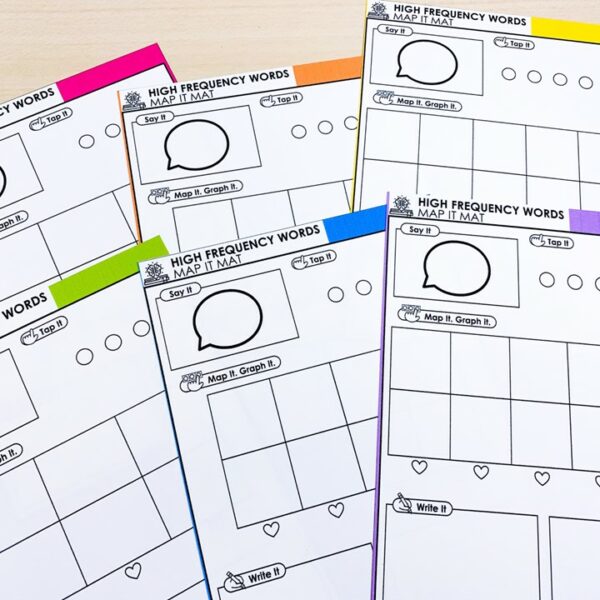
Do you love free stuff?
Sight Word Mapping Mats
These free Map It mats can be used to promote orthographic mapping of heart words and high frequency words in your small groups.
Reading
During the reading portion of your lesson, students will be working on reading words with the target skill in context.
We can break this portion of the lesson plan down into a smaller chunks as well:
Vocabulary
Just because a word is completely decodable doesn’t mean that students will have the background knowledge to comprehend it!
If there are any vocabulary words in your decodable story that you think students may not know, review them quickly before reading.
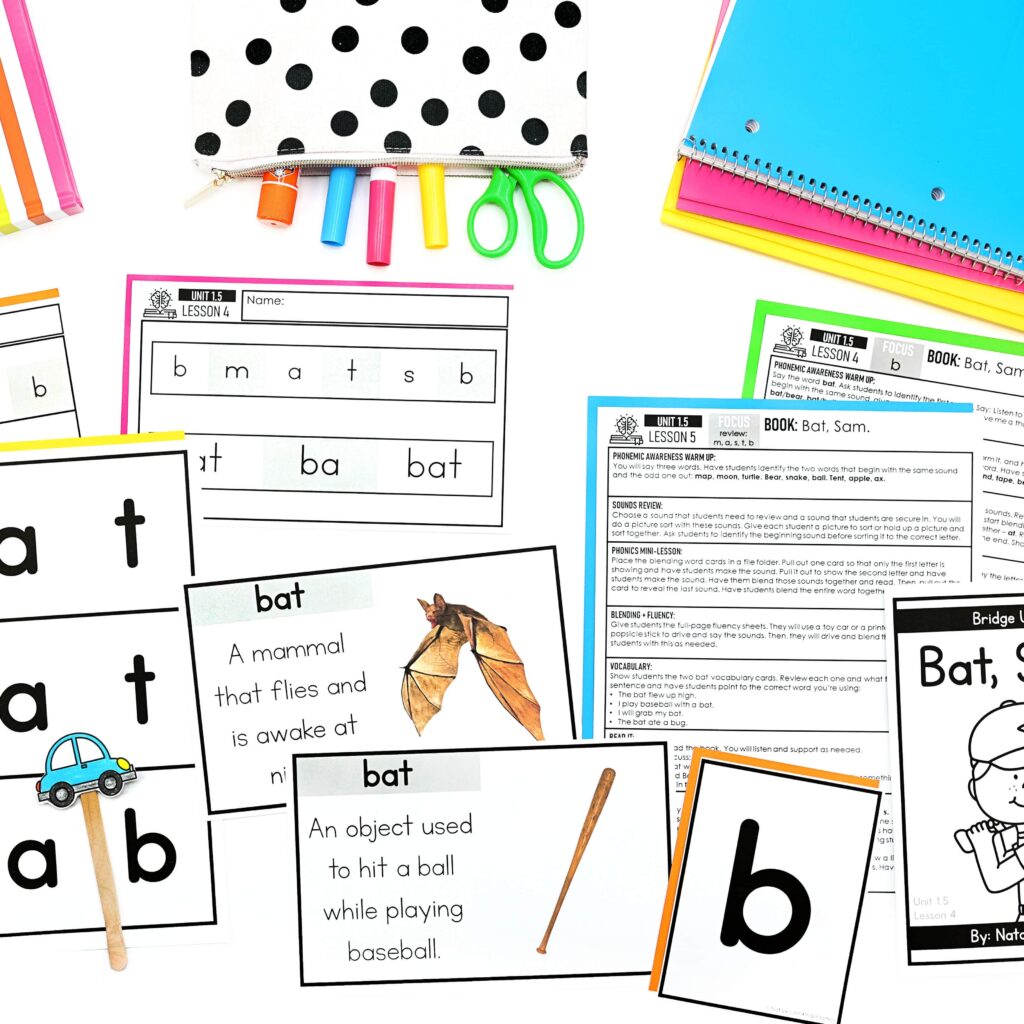
This can be as simple as showing students a real-life picture of the word, defining it, and asking students a question about the word to get them making connections.
For example, “This is jam. Looking at this picture, do you think you have ever had jam before? Is there another word we can use for jam?”
Reading the Story
Now it is time for students to read, read, read! It is important that students are doing the leg-work during this time. That means that you are not reading the story together; students are not taking turns reading; each student is reading the story on their own.
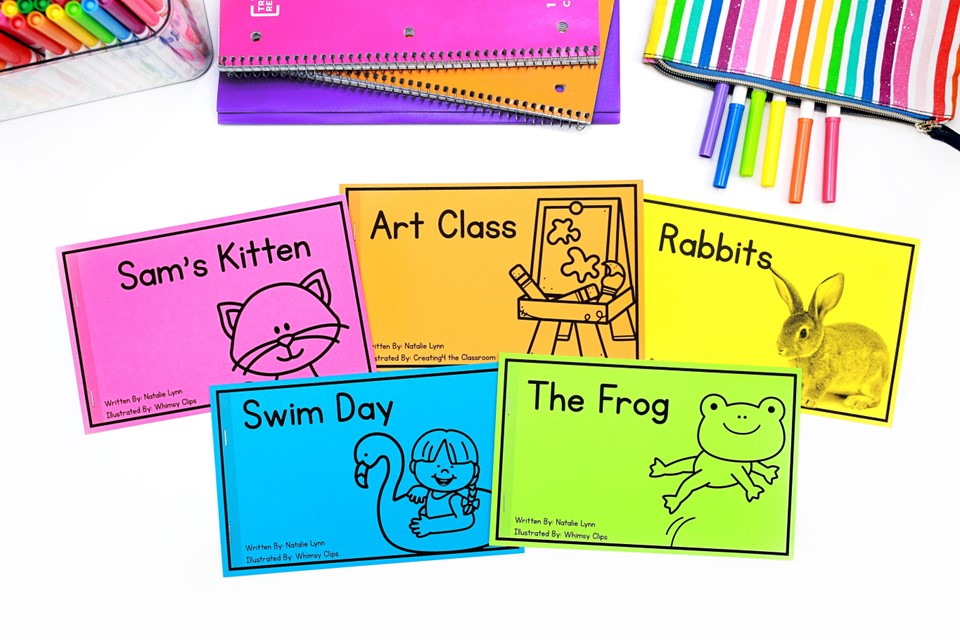
You do not necessarily have to use decodable readers during this portion of your lesson. Decodable passages are also a great alternative!
What is the teacher doing while students are reading? Your job during this time will be to listen to each student, assess, and offer support. That means that you can take decodable running records, take anecdotal notes on each student, or support a student in trying decoding strategies.

In the Science of Reading Guided Curriculum, you can choose decodable books with or without pictures. This allows you to further differentiate the lesson!
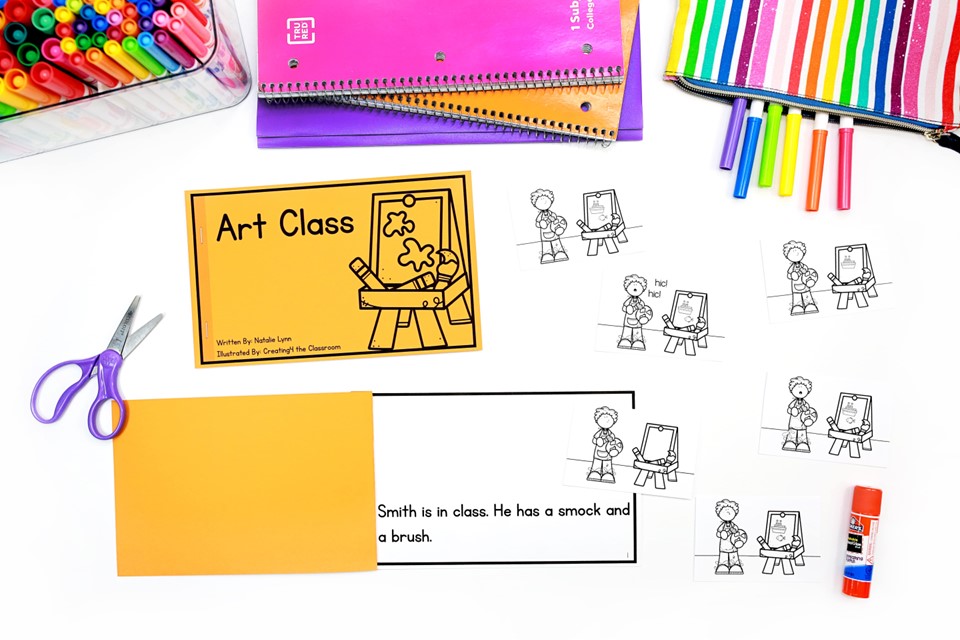
If you choose the decodable books without pictures, students will match the pictures to each page after reading. This is a powerful way to build in meaningful comprehension practice!
On day two, students will re-read the same book for fluency.
Teacher Tip: One of my favorite tools for small groups is whisper phones. For our beginning readers, they need to hear themselves read out loud to become fluent. These allow students to hear themselves reading without having to speak loudly.
Comprehension
Just because a story is decodable doesn’t mean that you can’t work on comprehension as well! While this may be more difficult at the earlier levels, you can still ask students questions to get them thinking about the text.
The comprehension portion of your lesson should be short and sweet as it is not the main focus.
This can look like:
- Asking students who the characters were or what the setting was.
- Asking students what happened in the story.
- Making connections or thinking deeper (Why do you think the character did that? What would you do in that situation?)
Writing
Now that you’ve practiced reading words with the target skill in both isolation and in context, it’s time to work on writing!
With a two-day lesson plan, I break this up into two different sections:
Day One – encoding practice
Day Two – guided writing
What does encoding practice look like?
During this time, students will practice mapping and writing words in isolation. For this, we use word mapping mats, but you can also simply use cubes and dry erase boards.
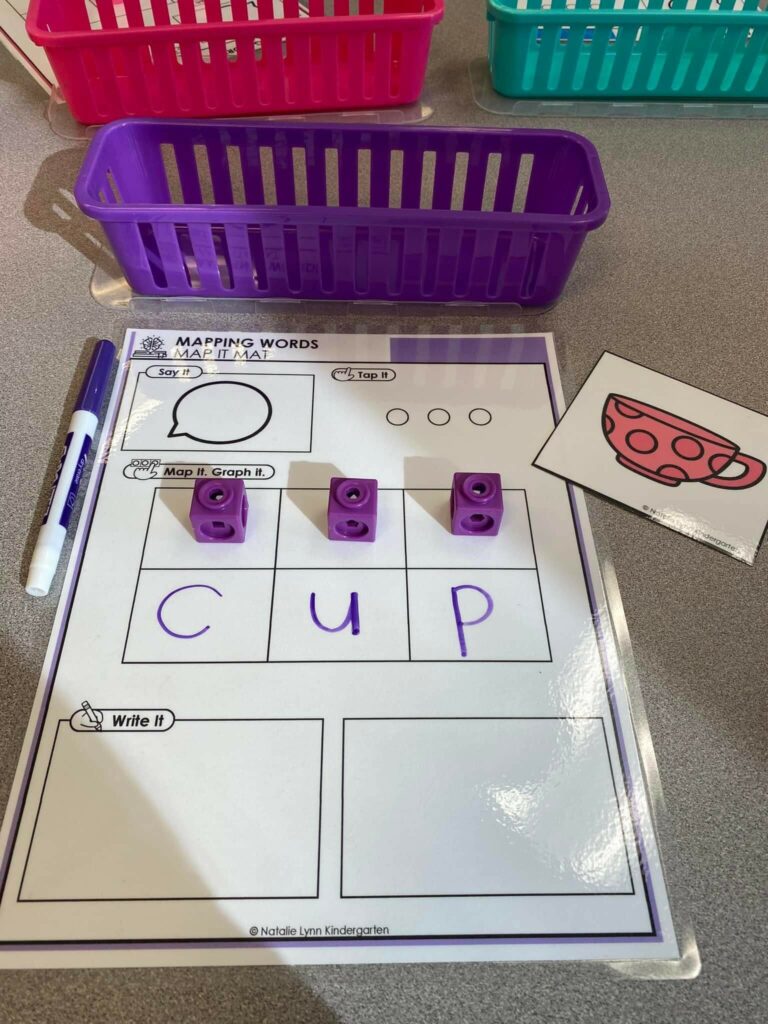
The encoding words routine looks like:
- You will say a word and students will repeat the word.
- Students will tap the sounds in the word with their finger and count how many sounds.
- Students will map the sounds in the word by putting out a cube or counter for each sound.
- Students will write the letter or letters that make each sound.
- Optional: You can have students re-write the word.
I know i’ve said it a thousand times, but I will say it again – keep this time short and sweet! We practice with 5-6 words at a time.
What does guided writing look like?
On day two of the lesson, we do guided writing. If you are familiar with guided writing from traditional guided reading groups, this routine will be familiar to you.
However we can make one little tweak that will make this a powerhouse portion of your lesson – use decodable sentences.
Really, that’s it!
You may also hear this activity called “dictated sentences.” I prefer guided writing because it allows for more flexibility later on (as you’ll see in a moment).
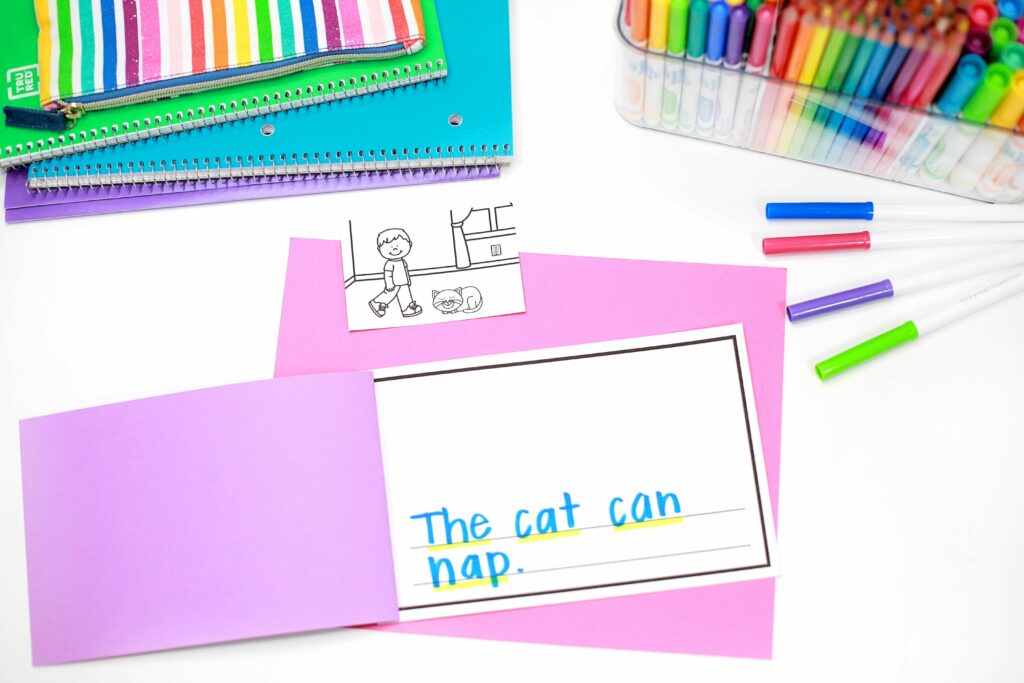
Our guided writing routine looks like:
- The teacher will say a sentence.
- The students will repeat the sentence.
- The students will pound their fist as they say the sentence again and count the words.
- Optional: For beginning writers, you might have them use a highlighter or pencil to draw a line for each word. You can also do this for them.
- Students will write the sentence. If students get stuck as they are writing, encourage them to go back and re-read the sentence to jog their memory.
- Students will read the sentence.
- Optional: Students can draw a picture to match the sentence.
Using decodable sentences for guided writing is an amazing way to work in writing words with your target phonics skill in context.
It also allows you to spiral in past skills for review!
Once your students are comfortable with writing, you can move to a less structured version of guided writing. This would most likely be in first grade, or around Unit 5 of the Science of Reading Guided Curriculum.
This would look like having your students write to retell the story or write to answer a question about the story.
Why is this beneficial? When students write to retell the story or write the answer a question about a story, they will naturally have to use words with the target phonics skill because those words were using throughout your decodable reader!
However, now students are being asked to think up these sentences on their own which brings a comprehension piece into it.
Ready? Let’s get plannning!
Now that you know the steps to plan the best Science of Reading aligned small group lesson plans, you can feel confident knowing that you can meet your readers where they are.
If you’re looking for a small group curriculum that makes it easy for you, the Science of Reading Guided Curriculum has everything that you could need and more!
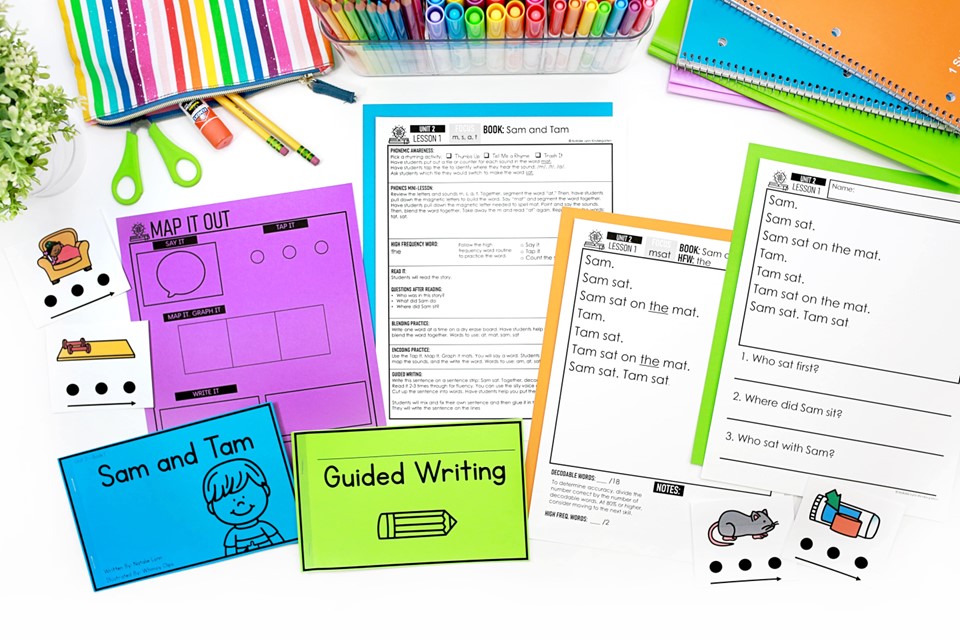
This was the first Science of Reading curriculum of its kind out there, and it’s already transformed THOUSANDS of classrooms!
The Science of Reading Guided Curriculum includes 11 units that cover kindergarten, first grade, and second grade phonics skills (or beyond that if you have students who still need support).
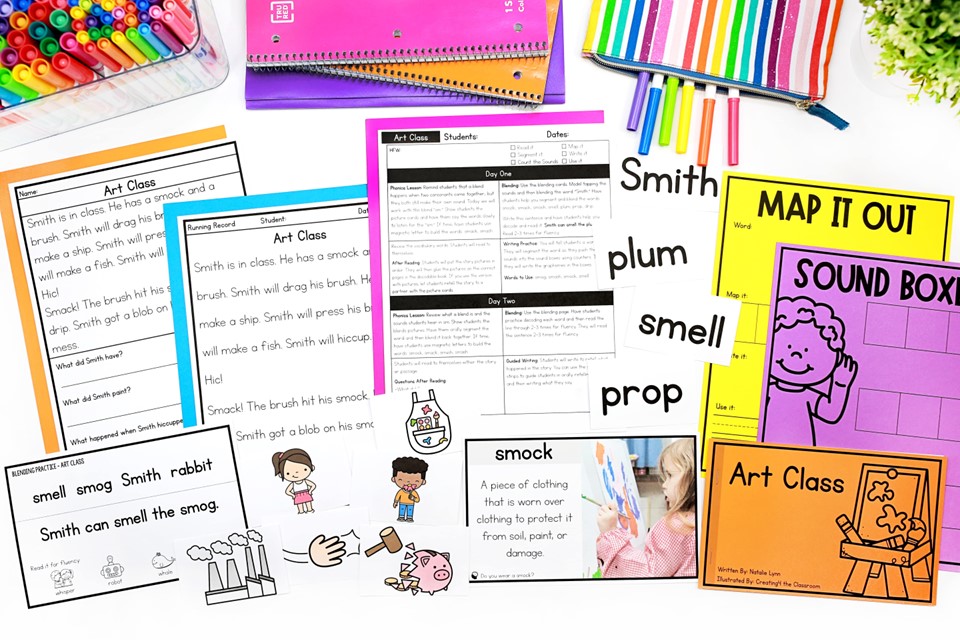
This curriculum was designed to be developmentally-appropriate for your students, which means that it includes multiple lessons and books for each skill. Students aren’t expected to master a skill in one lesson!
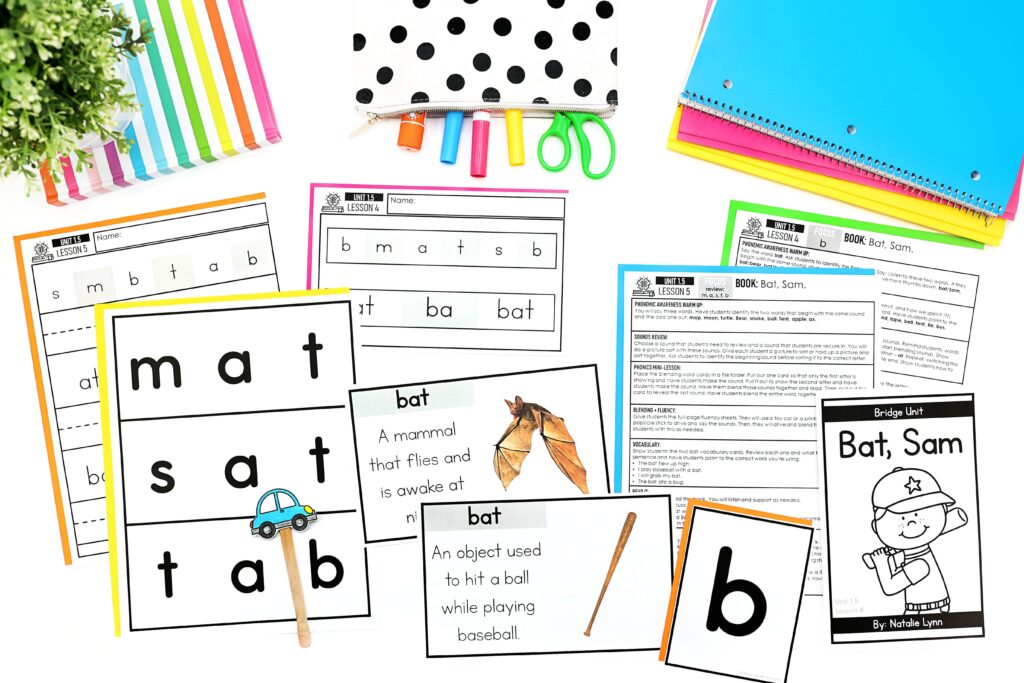
Each lesson, book, and unit builds on the previous lessons so that students are never asked to read words that they have not learned to decode (beyond a few high frequency words).
With the Science of Reading Guided Curriculum, you will get:
- 11 units with 236 lessons
- 236 decodable readers
- Books with and without pictures
- Decodable passages version
- Phonics materials including word cards, picture cards, and posters
- Blending half-pages sheets
- Guided writing materials
- Heart word routine
- Decoding strategy posters
- Syllable division strategies and multisyllabic word practice
It was also very important to me to keep this curriculum as affordable as possible for teachers. For that reason, you can save over 70% off by purchasing the whole curriculum.
Want a closer look at the curriculum and everything it includes? Check out this blog post here.
Have questions about implementing Science of Reading aligned small groups? Email me at [email protected]!
You can also check out some of these helpful blog posts:



